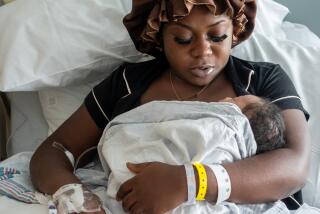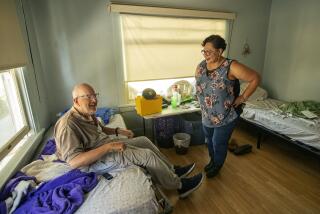Boarder Infants : Babies Gain a Lot From a Little TLC
NEW YORK — The infant gingerly reaches for Ed Belling’s mustache. Their eyes meet and a big baby grin spreads across the 2-month-old’s face.
The boy’s teen-age parents, homeless and drug addicted, aren’t there to capture the moment. But Belling is.
He is one of a growing number of 60-minute dads and moms. They give their time and love to help cuddle and care for the city’s small army of boarder babies--infants forced to live in sterile hospital settings.
Looking around the crowded nursery at St. Luke’s Hospital in Manhattan, Belling, an unmarried box-office clerk, prefers to dwell on the positive: “What I’ve done is given a tiny baby some nourishment, some comfort, even if it is only for an hour.”
Some Abandoned
The babies wind up in hospitals for various reasons. Some have been abandoned or have parents who can’t afford to take care of them. Most have parents who “aren’t fit to take care of them,” usually addicts, says Anne Ormsby of the city’s Human Resources Administration, which oversees the boarder baby program.
There are about 300 such infants in the city, most of them black or Latino; children who, at one point, spend as much as three months lying in steel-sided cribs and plastic bassinets, waiting to be put in foster homes.
Reforms in the system have since helped reduce that wait to an average of five days for healthy infants. But those with special needs can stay as long as eight months, says Carolyn Yordan of the Greater New York Hospital Assn., which represents 70 hospitals.
Boarder babies are fed and changed at regular intervals by already overburdened staff nurses.
But what about love?
Touch They Crave
That is where people like Belling come in. They are part of St. Luke’s-Roosevelt Medical Center’s volunteer program to give the infants the human touch they crave.
Nine women and eight men donate an hour each week to care for the hospital’s boarder babies.
“Before the volunteers came up to hold the babies in the nursery, the babies were not reactive to anything,” said Virginia Crosby, director of volunteers at the medical center. “They would just lie there.
“The staff would go in and feed them when they could. The babies didn’t even react to sound after a while.
“Once the volunteers started, it was totally different,” Crosby said. “They began to react to the love and you could see a real difference.”
Decorated by Nurses
The difference was there in the face of the month-old boy Loretta Donato gently rocked in a dilapidated rocking chair inside St. Luke’s boarder baby nursery, a small, gray-walled room that would be cheerless if not for the efforts of the staff nurses who used their own money to decorate it.
Eight tiny “cribs”--actually, miniature hospital beds, their iron sides disguised with white paint and brightened with colorful mobiles--dominate the room. The desolate hospital walls are masked with a wallpaper border of skating bunnies.
The “Alice in Wonderland” curtains remind Donato of the story of Alice’s tumble down the rabbit hole, and she tells it to the baby content in her lap.
Across the room, Ian McCart, who like Belling is single, expertly changes a 2-week-old girl’s diaper.
McCart, a Manhattan banker who lives in Westchester County, went to the hospital 18 months ago to volunteer to help AIDS patients and met Crosby.
‘I Was Hooked’
One day, she coaxed him into going upstairs to look at the babies. “I was hooked,” he said.
Now, every Thursday after work, he takes care of AIDS patients for an hour and then goes up to the nursery.
“I just love to sit quietly with the child and play (tape-recorded) classical music,” McCart said. “It’s the first peace I have all day long.”
For Mel Heiko, a 65-year-old lawyer with two grown daughters and a 9-month-old grandson, the volunteer program is a second chance to experience fatherhood.
When his own children were young, he said, “I was too busy trying to carve out a career.”
“Sometimes you sit there and wonder what’s going to happen to them,” said the 41-year-old Donato, a married advertising executive who would like to have children but says “nature has not been so kind.”
“I often sit there and create whole futures for them,” she said. “I like to think positive things. Maybe in some small way it will rub off.”
The volunteers never know where the babies go once they leave.
“I don’t think I want to know, to tell the truth,” Belling said. “A couple of times I’ve seen (the babies’) parents up there--it’s scary.
“I just think it’s better for us and better for the babies if we just spend that time with them, make that little bit of difference.”
More to Read
Sign up for Essential California
The most important California stories and recommendations in your inbox every morning.
You may occasionally receive promotional content from the Los Angeles Times.










